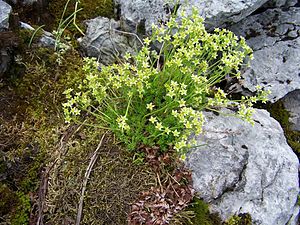Musk saxifrage
| Musk saxifrage | ||||||||||||
|---|---|---|---|---|---|---|---|---|---|---|---|---|

Musk saxifrage ( Saxifraga moschata ) |
||||||||||||
| Systematics | ||||||||||||
|
||||||||||||
| Scientific name | ||||||||||||
| Saxifraga moschata | ||||||||||||
| Wulfen |
The musk saxifrage ( Saxifraga moschata , also Saxifraga exarata ssp. Moschata ) is a plant of the genus saxifrage ( Saxifraga ). The Artepipheton moschata refers to the resinous smell of the plant.
features
The perennial herbaceous plant grows in dense cushions and is about 3 to 10 centimeters high. It smells strongly of resin. The leaves are usually three-columned, less often undivided and linear and, in contrast to the furrowed saxifrage ( Saxifraga exarata ), not or only indistinctly furrowed on top.
Each inflorescence consists of only one to five flowers . The five petals are narrowly egg-shaped, about as wide as the sepals and three to four millimeters long. The color is creamy to yellowish green or cloudy red. This is where the musk saxifrage also differs from the furrowed saxifrage, whose white or yellowish petals are about twice as wide as the sepals. The petals of the musk saxifrage are once or twice longer than the sepals.
The flowering period is July to August.
The chromosome numbers 2n = 22, 24, 26, 28, 32, 34, 36, 44 or 52 of this type are known.
Occurrence
The musk saxifrage grows in rocky lawns, on resting debris and in snow soils ( snow valleys ) between 1,200 and 4,000 meters (around the Finsteraarhorn ). It prefers calcareous rock, but is not bound to lime. It thrives on moderately fresh, neutral to mild, humus-rich, more or less fine-earth poor stone or rock soils. It occurs mainly in societies of the Seslerion association, also in the Elynetum and in societies of the order Potentilletalia caulescentis.
The range includes the mountains of southern and central Europe from the Pyrenees to the Balkans , the Carpathians and the Caucasus . In the Allgäu Alps , it rises from 1,800 meters to 2,600 meters above sea level.
Systematics
The very variable species was also known under the scientific name Saxifraga exarata subsp. moschata classified as a subspecies of the furrow saxifrage ( S. exarata ). This view has not yet prevailed. It is also not based on a thorough taxonomic revision of this family group, but primarily the fact that these plants are often difficult to distinguish and often form hybrids with one another.
The following clans, which some authors consider Saxifraga exarata , can also be counted as Saxifraga moschata :
- Saxifraga moschata subsp. basaltica Br.-Bl. , occurs only in the Giant Mountains
- Saxifraga moschata subsp. carniolica (Huter) T.Wraber , occurs only in Italy and Slovenia
- Saxifraga moschata subsp. fastigiata (Luizet) P. Fourn. , occurs only in the Pyrenees.
literature
- Xaver Finkenzeller: Alpine flowers , ISBN 3-576-11482-3 .
- Wolfgang Adler, Karl Oswald, Raimund Fischer: Excursion flora of Austria. Ed .: Manfred A. Fischer . Ulmer, Stuttgart / Vienna 1994, ISBN 3-8001-3461-6 .
- Klaus Kaplan in Gustav Hegi : Illustrated flora of Central Europe . 3rd edition Volume IV, Part 2 A, pages 208-209. Blackwell-Wissenschaftsverlag Berlin 1995. ISBN 3-8263-3016-1 .
Individual evidence
- ↑ a b Erich Oberdorfer : Plant-sociological excursion flora for Germany and neighboring areas . With the collaboration of Angelika Schwabe and Theo Müller. 8th, heavily revised and expanded edition. Eugen Ulmer, Stuttgart (Hohenheim) 2001, ISBN 3-8001-3131-5 , pp. 490 .
- ↑ Erhard Dörr, Wolfgang Lippert : Flora of the Allgäu and its surroundings. Volume 1, IHW, Eching 2001, ISBN 3-930167-50-6 , p. 655.
Web links
- Musk saxifrage. In: FloraWeb.de.
- Musk saxifrage . In: BiolFlor, the database of biological-ecological characteristics of the flora of Germany.
- Profile and distribution map for Bavaria . In: Botanical Information Hub of Bavaria .
- Saxifraga moschata Wulfen sl In: Info Flora , the national data and information center for Swiss flora . Retrieved November 1, 2015.
- Thomas Meyer: Data sheet with identification key and photos at Flora-de: Flora von Deutschland (old name of the website: Flowers in Swabia )

